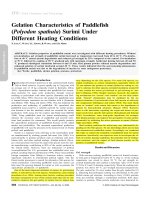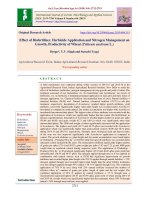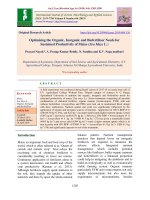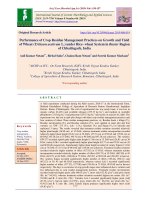Productivity of chickpea (Cicer arietinum L.) under different sowing date and seed rate in south west punjab
Bạn đang xem bản rút gọn của tài liệu. Xem và tải ngay bản đầy đủ của tài liệu tại đây (186.32 KB, 7 trang )
Int.J.Curr.Microbiol.App.Sci (2019) 8(5): 1419-1425
International Journal of Current Microbiology and Applied Sciences
ISSN: 2319-7706 Volume 8 Number 05 (2019)
Journal homepage:
Original Research Article
/>
Productivity of Chickpea (Cicer arietinum L.) under
Different Sowing Date and Seed Rate in South West Punjab
Amrinder Singh, Balwinder Singh Dhillon* and Ajmer Singh Sidhu
College of Agriculture, Guru Kashi University, Talwandi Sabo, India
*Corresponding author
ABSTRACT
Keywords
Chickpea, Date of
sowing, Flowering,
Seed rate and seed
yield
Article Info
Accepted:
12 April 2019
Available Online:
10 May 2019
A field experiment entitled “Effect of date of sowing and seed rate on growth and yield of
chickpea (Cicer arietinum L.)" was conducted at the Research Farm of Guru Kashi
University, Talwandi Sabo during rabi season 2016-17 and 2017-18. The experiment was
conducted in split plot design with combinations of three date of sowing viz., Oct 10, Oct
25 and Nov 10 in main plots and three seed rates viz., 37.5, 62.5 and 87.5 kg/ha in sub
plots, replicated thrice. The results showed that the crop sown on Oct 25th recorded
maximum plant population/m2 (15.2), plant height (61.2 cm), number of primary
branches/plant (4.1), number of fruit branches/plant (17.2), number of pods/plant (144.7),
number of grains/pod (1.90), 1000-grain weight (160.4 g), seed yield (20.1 q/ha), haulm
yield (30.2 q/ha), biological yield (50.3 q/ha) and harvest index (39.9%) than other date of
sowing (Oct 10th & Nov 10th). Days taken to 50% flowering (101.4) and days taken to
maturity (160.7) were significantly higher in Oct 10 sowing date than other sowing dates
(Oct 25th and Nov 10th). Similarly, seed rate @ 62.5 kg/ha recorded significantly higher
plant height (61.6 cm), number of primary branches (4.0), number of fruit branches (16.6),
number of pods/plant (138.7), number of grains/pod (1.92), 1000-grain weight (161.0 g),
seed yield (20.4 q/ha), biological yield (48.9 q/ha) and harvest index (41.7%) as compared
to other seed rates i.e. 37.5 and 87.5 kg/ha. Plant population/m2 (17.8), days taken to 50%
flowering (98.2), days taken to maturity (158.4) and haulm yield (29.9 q/ha) significantly
increase using seed rate 87.5 kg/ha. Crop sown on Oct 25th with seed rate @ 62.5 kg/ha
(D2S2) registered significantly higher in plant height (64.5), number of pods/plant (149.5),
number of grains/pod (2.14), 1000-grain weight (164.6 gm), seed yield (22.1 q/ha),
biological yield (52.2 q/ha) and harvest index (42.6 %) than other treatments.
Introduction
Chickpea (Cicer arietinum L.), the most
important pulse crop of rabi season, is
cultivated mainly in semi-arid and warm
temperate regions of the world. It is grown in
several countries worldwide as a food source.
It is, probably, the highest protein containing
gram legume expect groundnut and soybean.
Chickpea is the third most important food
legume crop and India is the largest producer
contributing to 65% of world’s chickpea
production (FAOSTAT, 2008). Even though
India is the largest producer of chickpea; it
still imports chickpea from other countries.
Chickpea is largely cultivated in the
temperate region.
1419
Int.J.Curr.Microbiol.App.Sci (2019) 8(5): 1419-1425
Chickpea is a premier pulse crop of India
grown in rabi season under various cropping
systems. In India, it is grown on an area about
9.91 million hectares with an annual
production of 8.22 million tones and average
productivity is 895 kg/ha. It contributes about
47% of the total pulse production and about
40% of total pulse growing area in the
country. In India, it is mainly grown in the
states of Andhra Pradesh, Bihar, Gujarat,
Haryana, Karnataka, Madhya Pradesh,
Maharashtra, Rajasthan, Uttar Pradesh, etc.
Among these states, Madhya Pradesh is the
largest producer of chickpea, which covers
2.79 million hectares area with an annual
production of 2.58 million tonnes. Chickpea
is an important source of protein in the diets
of the poor and is particularly important in
vegetarian diets. Also, it is being used
increasingly as a substitute for animal protein.
Optimum sowing time of chickpea may vary
from one variety to another and also from one
region to another due to variation of agroecological conditions.
In Punjab chickpea is usually sown between
mid October to mid November. However,
sowings are often delayed when grown in
sequence with kharif crops. The exposure of
crop to low temperatures during germination
and seedling establishment and to high
temperature during flowering and seed
formation phases under delay-sown chickpea
results in drastic reduction in yield. Yield loss
in chickpea can vary between 30 and 60%
depending on genotype, sowing time,
location, and climatic conditions during
sowing season. Some chickpea genotypes
have capacity to tolerate drought and in that
case sowing time can be delayed. However,
earlier or late sowing caused drastic reduction
in yield and net profit compared with timely
sowing. Among the various production
factors an optimum seed rate is prime
importance as it directly affects the micro
environment and growth pattern of individual
crop plant and thereby yield. Appropriate seed
rate would provide more efficient use of
available resources, via, soil moisture, and
nutrient will allow a crop to exert greater
inter-specific completion. The present study
was undertaken to find out the most suitable
sowing date as well as seed rate for improving
chickpea production.
Materials and Methods
The present investigation “Effect of date of
sowing and seed rate on growth and
productivity of chickpea” was conducted at
Research Farm of Guru Kashi University
Talwandi Sabo, Bathinda during rabi season
2016-17 and 2017-18. Talwandi Sabo is
situated at 29057’N latitude and 7507’E
longitude at a height of 213 meters above the
sea level. The climate of the experimental site
is characterized by semi-arid type with hot
and dry summer from April to June, hot and
humid from July to September and cold
winter from November to January. The
maximum temperature 24.80C was recorded
in the month of June and minimum
temperature 18.40C recorded in the month of
April. Maximum relative humidity (morning)
(90.7%) was recorded during the month of
January. Maximum rainfall (14.0mm) was
recorded in the month of November. The soil
of the experimental plot was sandy loam with
a pH of 7.8, low in organic carbon (0.34%),
low in available N (125.4 kg ha-1), medium in
available P (13.9 kg ha-1) and high in
available K (245.6 kg ha-1). The experiment
was laid out in split plot design. The
experiment was conducted in split plot design
with combinations of three date of sowing
viz., Oct 10, Oct 25 and Nov 10 in main plots
and three seed rates viz., 37.5, 62.5 and 87.5
kg/ha in sub plots, replicated thrice.
During the crop growth period, the following
observations were recorded from time to time.
Total number of plants was recorded from
1420
Int.J.Curr.Microbiol.App.Sci (2019) 8(5): 1419-1425
each plot. The height of five randomly
selected plants was measured at the maturity.
The total no of branches (primary and
fruiting) were counted from the five randomly
selected plants in each plot at maturity stage
and the average value was worked out. The
50% flowering time was recorded from each
plot at the flowering stage counting the
flowering plants and it divided by the total no.
of the plant population from each plot. The
period taken for 50 percent flowering under
different treatments was recorded from each
plot. The total number of pods per plant was
recorded from the 5 randomly selected plants
from each plot. After threshing the bunch of
five plants, the number of seeds were counted
and divided with total number of pods
recorded from these five plants to obtain
number of seeds/pod. The weight of 1000
grains was recorded from each plot and
expressed in gram (g). Number taken to
maturity days were counted from each plot
after the coluor of the plant and pod turned
yellow. After threshing of crop, the data on
grain and haulm yield was recorded from each
plot and expressed as kg/ ha. The total
biomass was recorded after complete drying
of the plant from each plot. Harvest index
(HI) was calculated by using following
formula:
Seed yield
Harvest index (%) = ––––––––––––––– x 100
Biological yield
Fisher’s ANOVA technique and least
significant difference (LSD) test at 5%
probability level was used to compare
differences among treatment means (Steel et
al., 1997).
Results and Discussion
Growth parameters
Significantly highest plant population was
recorded with seed rate of 87.5 kg/ha than
other seed rate treatments i.e. 37.5 and 62.5
kg/ha (Table 1). Maximum plant population
was observed in chickpea sown on Oct 25th
than other sowing dates i.e. Oct 10th and Nov
10th. The increase in plant population may be
attributed to more number of plants per unit
area and soil moisture availability. The
interaction effect of date of sowing and seed
rate was found to be non-significant for the
plant population.
Significantly highest plant height was
recorded with seed rate of 62.5 kg/ha than
other seed rate treatments i.e. 37.5 and 87.5
kg/ha. Maximum plant height was observed in
chickpea sown on Oct 25th than other sowing
dates i.e. Oct 10th and Nov 10th. The increase
in plant height may be attributed due to high
temperature availability at sowing time of
chick pea on Oct 25th as compared to at
sowing time of chick pea on Nov 10th. The
combining effect of date of sowing and seed
rate levels was found to be significant for the
plant height. The maximum plant height was
recorded in D2S2 (date of sowing in Oct 25th
with seed rate 62.5 @ kg/ha).
Significantly highest number of primary
branches/plant was recorded with seed rate of
62.5 kg/ha than other seed rate treatments i.e.
37.5 and 87.5 kg/ha. Maximum number of
primary branches/plant was observed in
chickpea sown on Oct 25th than other sowing
dates i.e. Oct 10th and Nov 10th. The more
number of primary branches of chickpea in S2
(seed rate @ 62.5 kg/ha) may be attributed to
specific space available for better plant
growth as compared to seed rate @ 37.5 kg/ha
and 87.5 kg/ha. The interaction effect of date
of sowing and seed rate was found to be nonsignificant for the no. of primary
branches/plant. The variation in the above
mentioned growth parameters have also been
reported by Aziz and Raman (1996), Yadav et
al., (1999), Chaitanya and Chandrika (2006)
and Mahse et al., (2006).
1421
Int.J.Curr.Microbiol.App.Sci (2019) 8(5): 1419-1425
Phenology
The data revealed that crop sown on Oct 10th
took more time to flowering as compared to
other sowing dates i.e. Oct 25th and Nov 10th
(Table 2). The data further revealed that seed
rate @ 87.5 kg/ha took significant more time
to 50% flowering than other seed rates @
62.5 kg/ha and 37.5 kg/ha. Interaction effect
between date of sowing and seed rate on 50%
flowering of chickpea. The maximum days
taken to 50% flowering was recorded in D1S3
(date of sowing in Oct 10th with seed rate 87.5
@ kg/ha).
The early date of sowing took more time to
maturity of chickpea. Maximum time taken
for maturity was observed in case of sowing
of chick pea on Oct 10th than other sowing
dates i.e. Oct 25th and Nov 10th. The data
further elucidated that plots with seed rate of
chick pea @ 87.5 kg/ha took more time to
maturity as compared to seed rate of chick
pea @ 37.5 kg/ha and 62.5 kg/ha. The
interaction effect between date of sowing and
seed rate was significant. The maximum days
taken to maturity was recorded in D1S3 (date
of sowing in Oct 10th with seed rate 87.5@
kg/ha). The variation in the above mentioned
phenology parameters have also been reported
by Kumar et al., (2001), Sugui and Sugui
(2002) and Valimohammadi (2007) (Table 3).
The highest number of pods/ plant was
observed in chickpea sown on Oct 25th
followed by Oct 10th and Nov 10th. The data
further indicated that seed rate of chick pea @
62.5 kg/ha gave significantly higher the
number of pods/plant than 37.5 kg and 87.5
kg/ha seed rate. The interaction effect of date
of sowing and seed rate was found to be
significant. The maximum number of pods
were recorded in D2S2 (date of sowing on Oct
25th with seed rate of chickpea @ 62.5 kg/ha).
The significantly maximum number of
grains/pod was recorded in S2 (seed rate @
62.5 kg/ha). The different date of sowing of
chickpea had significant effect on the number
of grains/pod. The significantly higher
number of grains/pod was recorded in date of
sowing of chickpea sown on Oct 25th. The
interaction effect of date of sowing of
chickpea and seed rate was found to be
significant. The number of grains/pod found
significantly higher in D2S2 (date of sowing of
chickpea on Oct 25th with seed rate @ 62.5
kg/ha). The data showed that thousand grain
weights of chickpea was significantly higher
in crop sown on Oct 25th as compared to Oct
10th and Nov 10th. Similarly, among different
seed rates maximum thousand grain weight in
seed rate @ 62.5 kg/ha as compared to other
seed rates @ 37.5 and 87.5 kg/ha. The
interaction effect between date of sowing and
seed rate on 1000 grain weight was significant
in chickpea.
Yield attributes of chickpea
Yield of chickpea
Significantly highest number of fruit
branches/plant was recorded with seed rate of
62.5 kg/ha than other seed rate treatments i.e.
37.5 and 87.5 kg/ha (Table 4). Maximum
number of fruit branches/plant was observed
in chickpea sown on Oct 25th than other
sowing dates i.e. Oct 10th and Nov 10th. The
interaction effect of date of sowing and seed
rate was found to be non-significant for the
number of fruit branches/plant.
The highest seed yield was observed in seed
rate @ 62.5 kg/ha treatment which was
significantly higher than other seed rates i.e.
37.5 and 87.5 kg/ha (Table 4). The sowing of
chickpea on Oct 25th gave significantly higher
seed yield over sowing of chickpea in Oct 10th
and sowing of chickpea in Nov 10th. The
increase in seed yield is attributed to
sufficient storage of soil moisture,
temperature and nutrient uptake, better plant
1422
Int.J.Curr.Microbiol.App.Sci (2019) 8(5): 1419-1425
growth in case of optimum time of sowing of
chickpea which resulted in higher number of
fruit branches, number of pods/plant and
1000-grain weight.
Table.1 Effect of date of sowing and seed rate on growth parameters of chickpea
(Pooled data over two years)
Treatment
Date of sowing
October 10
October 25
November 10
CD (P=0.05)
Seed rate (kg/ha)
37.5
62.5
87.5
LSD (P=0.05)
Interaction
Plant
population/m2
Plant height (cm)
No. of primary
branches/plant
15.0
15.2
14.8
0.13
59.0
61.2
56.2
0.27
3.5
4.1
3.0
0.12
12.6
14.7
17.8
0.12
NS
58.4
61.6
56.4
0.31
0.54
3.1
4.0
3.5
0.13
NS
Table.2 Effect of date of sowing and seed rate on days taken to 50% flowering of chickpea
(Pooled data over two years)
Date of
sowing
October 10
October 25
November
10
Mean
LSD (P=0.05)
37.5
98.3
94.0
85.7
Days taken to 50% flowering
Seed rate (kg/ha)
62.5
101.3
96.7
89.3
92.7
Date of sowing: 1.06
95.8
Seed rate: 0.48
Mean
87.5
104.7
99.7
93.3
101.4
96.8
89.4
98.2
Interaction (DxS) : 0.83
Table.3 Effect of date of sowing and seed rate on days taken to 50% maturity in chickpea
(Pooled data over two years)
Date of
sowing
October 10
October 25
November 10
Mean
LSD (P=0.05)
Days taken to maturity
Seed rate (kg/ha)
37.5
62.5
87.5
157.3
160.3
164.3
151.7
155.3
159.3
146.3
149.3
151.7
151.8
155.0
158.4
Date of sowing: 0.79
Seed rate: 0.60
1423
Mean
160.7
155.4
149.1
Interaction: 1.05
Int.J.Curr.Microbiol.App.Sci (2019) 8(5): 1419-1425
Table.4 Effect of date of sowing and seed rate on yield and yield attributes of chickpea
(Pooled data over two years)
Treatment
Date of sowing
October 10
October 25
November 10
LSD (P=0.05)
Seed rate (kg/ha)
37.5
62.5
87.5
LSD (P=0.05)
Interaction
No. of
fruit
branches
/ plant
No. of
pods per
plant
No. of
grains
per pod
1000grain
weight
(g)
Seed
yield
(q/ha)
Haulm
yield
(q/ha)
Biological
yield
(q/ha)
Harvest
index (%)
15.2
17.2
14.1
0.19
135.5
144.7
124.4
0.38
1.77
1.90
1.60
0.06
157.8
160.4
154.1
0.40
18.7
20.1
17.3
0.35
28.5
30.2
27.4
0.43
47.2
50.3
44.6
0.58
39.5
39.9
38.7
0.52
14.3
16.6
15.5
0.20
NS
131.0
138.7
135.1
0.42
0.72
1.62
1.92
1.73
0.02
0.04
154.2
161.0
157.1
0.45
0.78
17.3
20.4
18.4
0.29
0.50
27.6
28.5
30.0
0.25
0.43
44.8
48.9
48.4
0.32
0.55
38.4
41.7
38.1
0.46
0.79
The interaction effect of date of sowing of
chickpea and seed rate was also significant
with respect to the seed yield. Crop sown Oct
25th with using seed rate @ 62.5 kg/ha
recorded the maximum seed yield than other
treatments. The haulm yield was significantly
higher in date of sowing of chickpea on Oct
25th than other sowing dates i.e. Oct 10th and
Nov 10th.
The haulm yield was significantly higher in
seed rate @ 87.5 kg/ha than other seed rates
treatments i.e. 37.5 and 62.5 kg/ha. The
interaction effect of date of sowing of
chickpea and seed rate was also found
significant. Crop sown on Oct 25th with seed
rate @ 87.5 kg/acre produced the maximum
haulm yield than other treatments. The
significantly higher biological yield was
recorded in date of sowing on Oct 25th than
other sowing dates i.e. Oct 10th and Nov 10th.
The highest biological yield was recorded in
the seed rate @ 62.5 kg/ha than other seed
rates i.e. 37.5 and 87.5 kg/ha. The interaction
effect of date of sowing and seed rate on
biological yield was also found to be
significant. The maximum yield was recorded
in treatment D2S2 (date of sowing on Oct 25th
with seed rate @ (62.5 kg/acre) than other
treatments.
The highest harvest index (HI) was found in
date of sowing on Oct 25th than other sowing
dates Oct 10th and Nov 10th. The different
seed rates had significant effect on harvest
index. The treatment seed rate @ 62.5kg/ha
showed the highest (HI) than other seed rates
treatments i.e. 37.5 and 87.5 kg/ha.
The interaction effect of date of sowing and
seed rate on harvest index was also
significant. The treatment D2S2 (date of
sowing on Oct 25th with seed rate @ 62.5
kg/ha) recorded the highest harvest index than
other treatments. On the perusal of data, it is
clear that for obtaining higher seed yield of
chickpea, sowing of chickpea on Oct 25th with
seed rate of 62.5 kg/ha seems optimum. The
yield reduction under late sowing dates have
been similar results were also reported earlier
by also Srivastava et al., (1990), Paikaray and
Misra (1992), Singh and Dixit (1992), Dixit et
al., (1993) and Singh et al., (1988).
1424
Int.J.Curr.Microbiol.App.Sci (2019) 8(5): 1419-1425
In conclusion, the growth and yield
parameters were higher in Oct 25th date of
sowing than the other date of sowing i.e. Oct
10th and Nov 10th. The seed rate @ 62.5kg/ha
gave better growth and yield parameters than
the other seed rate @ 37.5 and 87.5 kg/ha.
Crop sown on Oct 25th and using seed rate @
62.5kg/ha seems optimum for obtaining
higher seed yield.
References
Aziz, M.A. and Rahman, M.V. (1996). Effect
of date of sowing on yield and yield
components of Kabuli gram (Cicer
arietinum L.). Indian Journal of
Agriculture Science, 64(9): 624-626.
Chaitanya, S.K., and Chandrika, V. (2006).
Performance of chickpea varieties
under varied dates of sowing in
Chittoor District of Andhra Pradesh.
Legume Research, 29(2): 137-139.
Kumar, Mahesh, R.C., Singh, Rakesh, Kumar,
Sanjay and Singh. (2001). Effect of
date of sowing and row spacing on the
performance of chickpea genotypes.
Haryana journal of Agronomy, 19(2):
140-141.
Mahse, L.B., Beshmukh D.V., and.
Jamadagni, B.M. (2006). Varietal
improvement of chickpea for rainfed
and late sown conditions. Annual
Review of Plant Physiology, 20(2):
177-180.
Paikaray, R.K., and Misra, R.C. (1992).
Performance of chickpea under
different dates of sowing in the
Esatern Ghat Highland Zone of
Orissa, India. ICN 27: 24-25.
Shrivastava, S.K., Ram Singh. and
Chandrawamshi,
B.R.
(1990).
Response of chickpea dates of sowing
in Chhattisgarh Region of Madhya
Pradesh. ICN 23: 26-27.
Singh, R.C., Maher, S. and Singh, M. (1988).
Studies on the spacing and seed rate of
small and bold seeded gram varieties
under rain fed condition. Haryana
Journal of Agronomy, 4(1): 28-30.
Singh, V.K., and Dixit, R.S. (1992). Effect of
moisture regime and sowing date on
chickpea (Cicer arietinum L.). Indian
Journal of Agronomy, 37(4): 739-743.
Steel, RGD, Torrie JH. Principles and
procedures of statistics: A biometrical
approach. 2nd Ed. McGraw-Hill,
Singapore, 1981.
Sugui, F.P. and Sugui, C.C. (2002). Response
of chickpea to dates sowing in Ilocos
Norte, Philippines. ICPN 9: 13-15.
Valimohammadi, F., Tajbakhsh, M. and
Saeid, A. (2007). Comparison Winter
and Spring Sowing Dates and Effect
of Plant Density on Yield, Yield
Components and Some Quality,
Morphological Traits of Chickpea
(Cicer
arietinum
L.)
Under
Environmental Condition of Urmia,
Iran. Journal of Agronomy, 4: 571575.
How to cite this article:
Amrinder Singh, Balwinder Singh Dhillon and Ajmer Singh Sidhu. 2019. Productivity of
Chickpea (Cicer arietinum L.) under Different Sowing Date and Seed Rate in South West
Punjab. Int.J.Curr.Microbiol.App.Sci. 8(05): 1419-1425.
doi: />
1425









